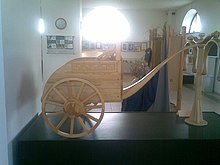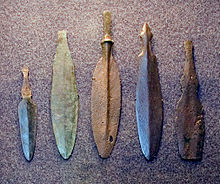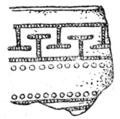Srubnaya culture
You can help expand this article with text translated from the corresponding article in Russian. (November 2018) Click [show] for important translation instructions.
|
Sauromatians |
The Srubnaya culture (
The Srubnaya culture is generally associated with archaic Iranian-speakers.[3][4] The name comes from Russian сруб (srub), "timber framework", from the way graves were constructed.
Distribution


The Srubnaya culture occupied the area along and above the north shore of the Black Sea from the Dnieper eastwards along the northern base of the Caucasus to the area abutting the north shore of the Caspian Sea, west of the Ural Mountains.[3] Historical testimony indicate that the Srubnaya culture was succeeded by the Scythians.[3]
Characteristics
The Srubnaya culture is named for its use of timber constructions within its burial pits. Its cemeteries consisted of five to ten kurgans. Burials included the skulls and forelegs of animals and ritual hearths. Stone cists were occasionally employed.[3] Srubnaya settlements consisted of semi-subterranean and two-roomed houses. The presence of bronze sickles, grinding stones, domestic cattle, sheep and pigs indicate that the Srubnaya engaged in both agriculture and stockbreeding.[3]
The use of chariots in the Srubnaya culture is indicated by finds of studded antler cheek-pieces (for controlling chariot horses), burials of paired domesticated horses, and ceramic vessels with images of two-wheeled vehicles on them.[5][6] The predecessor of the Srubnaya culture, a variant of the Abashevo culture known as the Pokrovka type, is considered to be an important part of the early ‘chariot horizon’, representing the rapid spread of the 'chariot complex'.[7][8]
Language
The Srubnaya culture is generally considered to have been Iranian.[3][4] Its area, which coincides with the presence of Iranian hydronyms,[4] has been suggested as a staging region from which the Iranian peoples migrated across the Caucasus into the Iranian Plateau.[3]
Genetics
Mathieson et al. (2015).
A 2017 genetic study published in Scientific Reports found that the Scythians shared similar mitochondrial lineages with the Srubnaya culture. The authors of the study suggested that the Srubnaya culture was ancestral to the Scythians.[11]
In 2018, a genetic study of the earlier Srubnaya culture, and later peoples of the
In a genetic study published in
In a 2023 study, one sample from the site Nepluyevsky, belonging to Srubnaya-Alakul culture and located in Southern Urals, (c. 1877 to 1642 calBC), (2-sigma, 95.4%), featured Y-haplogroup R1a1a1b2a (R1a-Z94), and other not dated sample featured R1a1a1b2 (R1a-Z93).[14]
Gallery
-
Ceramic sherd
-
Bronze axes
-
Horse bridle items
-
Reconstructed Srubnaya hut
-
Timber grave and tumulus
-
Dispersion of double-horse burials ca. 2000-1400/1300 BCE.[15] Horses were domesticated on the Pontic-Caspian steppe.[16]
See also
| Part of a series on |
| Indo-European topics |
|---|
 |
- Trzciniec culture
- Tumulus culture
- Nordic Bronze Age
- Unetice culture
Notes
- ^ "We observed a main cluster of Sintashta individuals that was similar to Srubnaya, Potapovka, and Andronovo in being well modeled as a mixture of Yamnaya-related and Anatolian Neolithic (European agriculturalist-related) ancestry."[13]
- ^ "Genetic analysis indicates that the individuals in our study classified as falling within the Andronovo complex are genetically similar to the main clusters of Potapovka, Sintashta, and Srubnaya in being well modeled as a mixture of Yamnaya-related and early European agriculturalist-related or Anatolian agriculturalist-related ancestry."[13]
- ^ "Corded Ware, Srubnaya, Petrovka, Sintashta and Andronovo complexes, all of which harbored a mixture of Steppe_EMBA ancestry and ancestry from European Middle Neolithic agriculturalists (Europe_MN). This is consistent with previous findings showing that following westward movement of eastern European populations and mixture with local European agriculturalists, there was an eastward reflux back beyond the Urals."[13]
References
- ^ Brown, Dorcas, and David Anthony, (2017). "Bronze Age Economy and Rituals at Krasnosamarskoe in the Russian Steppes", in: The Digital Archaeological Record: "...Particular attention focuses on the role of agriculture during the unusual episode of sedentary, settled pastoralism that spread across the Eurasian steppes with the Srubnaya and Andronovo cultures (1900-1200 BC)..."
- ^ Parpola, Asko, (2012). "Formation of the Indo-European and Uralic (Finno-Ugric) language families in the light of archaeology: Revised and integrated ‘total’ correlations", in Mémoires de la Société Finno-Ougrienne, Helsinki, p. 140.
- ^ a b c d e f g h i j Mallory & Adams 1997, pp. 541–542.
- ^ a b c Kuzmina 2007, p. 452.
- S2CID 254743380.
- .
From 2100/2000–1400/1300 b.c., paired burials of complete horses were interred in several centers, from the Kazakh steppes in central Asia in the east to as far as the Małopolska Upland in the west and the Peloponnese to the south. The earliest are connected to the Sintashta-Petrovka cultural complex in the southern Ural area, while later ones are associated with various other steppe and forest-steppe groups, such as the Andronovo, Potapovka, Alakul, and Srubnaya cultures
- S2CID 254743380.
- ^ Kuzmina 2007, p. 256.
- PMID 30713341.
- ^ Mathieson 2015.
- PMID 28266657.
- PMID 30417088.
- ^ a b c d Narasimhan 2019.
- PMID 37603728.
- ISSN 0093-4690.
- PMID 34671162.
- .
Bibliography
- Kuzmina, Elena E. (2007). The Origin of the Indo-Iranians. Brill. ISBN 978-90-04-16054-5.
- ISBN 1884964982.
- Mathieson, Iain (2015). "Genome-wide patterns of selection in 230 ancient Eurasians". PMID 26595274.
- Narasimhan, Vagheesh M. (2019). "The formation of human populations in South and Central Asia". PMID 31488661.
External links
 Media related to Srubna culture at Wikimedia Commons
Media related to Srubna culture at Wikimedia Commons- Srubnaya sundial
- Marks of heliacal rising of Sirius on the sundial of the Bronze Age






![Dispersion of double-horse burials ca. 2000-1400/1300 BCE.[15] Horses were domesticated on the Pontic-Caspian steppe.[16]](http://upload.wikimedia.org/wikipedia/commons/thumb/6/65/Dispersion_of_double-horse_burials_ca._2000_to_1400-1300_BCE.png/120px-Dispersion_of_double-horse_burials_ca._2000_to_1400-1300_BCE.png)
![Forensic reconstruction of a young woman (20-25), from the Aksay I cemetery, kurgan 9, burial 6, Late Bronze Age, Srubnaya culture.[17]](http://upload.wikimedia.org/wikipedia/commons/thumb/5/5e/Reconstruction_of_a_young_woman_%2820-25%29%2C_from_the_Aksay_I_cemetery%2C_kurgan_9%2C_burial_6%2C_Late_Bronze_Age%2C_Srubnaya_culture.jpg/89px-Reconstruction_of_a_young_woman_%2820-25%29%2C_from_the_Aksay_I_cemetery%2C_kurgan_9%2C_burial_6%2C_Late_Bronze_Age%2C_Srubnaya_culture.jpg)